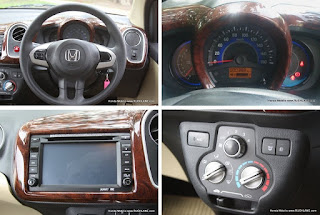 |
| Honda Mobilio |
Unlike most MPVs the world over, the Mobilio comes across as a less boxy design. Its squat stance belies the fact that it has class-leading ground clearance. The face has the typical Honda family look, with bulbous headlamps and a big chrome bar at the centre. The bumper is sleeker with a nice two-tone finish. The side profile provides you with a slightly better idea of its size. The Mobilio sits on the same platform as the Brio and Amaze, but it has an extended wheelbase. The roof tapers slightly towards the end. But, a blacked-out D-pillar gives it a sort of sedan look, making it appear less bulky. The rear windowsill has a dip, which gives it a bigger glass area. The Mobilio looks best from the rear, with the hatch having a nice sophisticated look.
The first thing that strikes you when you step inside is the space. The seats are slimmer and can be slid and folded into various combinations to offer a lot of flexibility. In many ways, it is similar to the combination we see in the Ertiga, with 60:40 split second row seats complete with an armrest. And, the seats fold up in one, swift convenient flip. For its compact dimensions, the car has commendable legroom and headroom. All seats can be reclined as well, and seven average-size adults can sit in reasonable comfort. There is enough space for two aircraft cabin-luggage-size suitcases in the boot, even with third-row seating. The latter can fold to free up the considerably huge luggage area. Most of the flooring is flat, which adds to the spaciousness.
Honda will officially launch the car later this month, but we are expecting the usual three trim levels: E, S and V. Featured here is the top V variant, which gets faux wood fittings on the dash and the door, and faux leather seats. The dashboard is pretty simple and, like in the Amaze, features ordinary-looking air-con dials at the centre. But, the Mobilio gets a large LCD display for multimedia and GPS. The display also doubles up as the screen for the reversing camera – yes, the top-spec Mobilio gets that, too. Plastic quality isn’t that great, and fit and finish is a bit of a mixed bag. While Hondas are not known to have unreliable interiors, the finish could have been better. We noticed a tacky wire for the USB/iPod/aux port jutting out of the glovebox, which doesn’t shut flush.
Under the hood are the tried-and-tested engine options from the stable. The petrol is a 1497cc unit with 117bhp and 145Nm of torque, the same motor that powers the City. Typically, at idle, you can hardly hear it, and, at revs, it is pretty smooth. This is mated to a five-speed manual gearbox, which feels a bit clunky while shifting. The Mobilio has a certified fuel efficiency figure of 17.3kpl under ideal conditions. So, expect it to be around 13-14kpl at best in the real world. The diesel, of course, is more frugal and certified for 24.2kpl. We expect it to deliver around 16-17kpl, which is not bad for a seven-seater. The diesel unit, again, is at the same level of tune as the motor that does duty in the City. The gearbox ratios have become a bit taller, though, and that has only bettered the overall driveability of the diesel. We drove it on the Mumbai-Nasik highway and on twisty back roads, and the diesel engine seemed to be more useable than the petrol variant.
On the move, the Mobilio is quite pliant over most surfaces, although the suspension is a bit on the stiffer side. Quick lane changes are not greeted by MPV-style body roll. What also helps in inspiring confidence is the well-weighted steering wheel. In the petrol version, there is considerable road noise coming into the cabin. You may not notice that in the diesel version, because the engine’s inherently noisy nature overpowers the road noise. Nevertheless, for a long distance runner, the Mobilio is reasonably powerful, and you won’t have a problem cruising at three-digit speeds.
MPVs aren’t new to Honda. They make popular full-size ones around the world. But, with the Mobilio, their first foray into the compact MPV segment, they seem to have covered most bases. The Mobilio isn’t exactly handsome, but it doesn’t have a boxy design like most MPVs. Plus, interior space has been utilised well to offer reasonable comfort to five or seven passengers and their luggage. The car lacks a bit in interior finesse with ordinary-looking dials and air-con vents. Even plastic finish is quite average, which shouldn’t have been the case, considering Honda will charge a premium on the car compared to the Ertiga. But, it has tried to make up for that by offering robust powertrains from the City. The Mobilio makes a safe alternative to a sedan by offering the additional benefit of a useable third-row seat. And, if that is absolutely essential to your purpose, this Honda makes the cut. Else, you have other options.



No comments:
Post a Comment